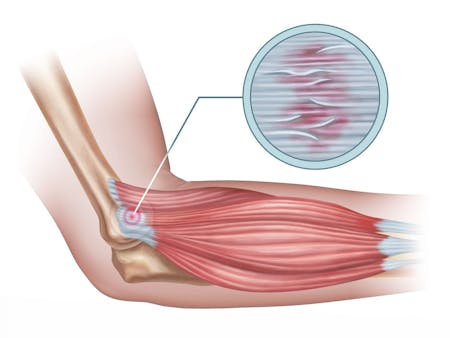Tennis Elbow
The elbow joint is made up of three bones: the upper arm bone (humerus) and the two bones in the forearm (radius and ulna). Muscles, ligaments, and tendons hold the elbow joint together. There are two bony bumps at the bottom of the humerus are called epicondyles. The inner one is called the medial epicondyle. The outer one is called the lateral epicondyle.
What is tennis elbow?
Tennis elbow (lateral epicondylitis) is a painful type of tendinitis. This is inflammation or microtearing of, most typically, the Extensor Carpi Radialis Brevis (ECRB) - the extensor tendon - where it attaches to the lateral epicondyle. The inflammation causes pain and tenderness on the outer side of the elbow, which may radiate into the forearm. Tennis elbow is most common among men between the ages of 30 and 50 but can occur in both males and females of all ages. Less than 5% of people who get tennis elbow don't play tennis.
What causes tennis elbow?
Tennis elbow is caused by repetitive gripping activities, particularly using the thumb and first two fingers. Sometimes, the cause is unknown (idiopathic). The forearm muscles and tendons become damaged from overuse over time. Symptoms generally become worse with a forceful forearm, wrist and hand activity, including holding a racquet in racquet sports, lifting, twisting or pulling.
What are the symptoms?
Symptoms may include:
- Pain or burning in the outer part of the elbow (lateral epicondyle) that may radiate into the forearm
- Weak grip
- Weakness in the forearm, wrist or hand
- Nighttime pain
- Elbow stiffness
How is tennis elbow treated?
It is important to treat tennis elbow as soon as possible. Not treating it promptly can cause it to become become chronic and last for months and maybe even years. Some of the common treatments for tennis elbow include:
- Physical therapy
- Ice - apply for 15 minutes three to four times a day
- Wrap the injured elbow with Ace wraps or use a brace or support
- An elbow strap to protect the injured tendon
- Aspirin or nonsteroidal anti-inflammatory (NSAIDs), such as ibuprofen or naproxen
If you're suffering from tennis elbow, call our office right away to make an appointment.
Carpal Tunnel Syndrome
Carpal Tunnel Syndrome (median nerve compression) is a common condition that causes numbness, tingling or weakness and pain in the hand and wrist as a result of pressure on the median nerve. The median nerve is a major nerve to the hand that runs the length of the arm, goes through the carpal tunnel and ends in the hand. It provides feeling in the thumb, index finger, middle finger and inside half of the ring finger, as well as controlling the muscles around the base of the thumb. The carpal tunnel is a narrow passageway in the wrist that protects the median nerve and nine flexor tendons that bend the fingers and thumb.
Who can get carpal tunnel?
Carpal tunnel occurs more frequently in people between the ages of 30 and 60. It can be caused by overuse, repeated movements that overextend the wrist, prolonged exposure to vibrations from power tools or a variety of conditions including:
- Diabetes
- Thyroid disorders
- Fluid retention due to pregnancy or menopause
- High blood pressure
- Autoimmune disease, such as rheumatoid arthritis
- Fractures or trauma to the wrist
What are the symptoms?
Carpal tunnel symptoms may include:
- Numbness, tingling and pain in the thumb and first three fingers of the hand
- Pain and burning sensation that radiates up the arm
- Nighttime wrist pain that interferes with sleep
- Hand muscle weakness that can cause a person to drop objects
How is carpal tunnel syndrome treated?
In 2008, the Academy of Orthopaedic Surgeons released guidelines for the effective treatment of carpal tunnel, which was to try to manage it without surgery, if possible.
Non-surgical treatments include:
- Physical therapy
- Avoiding positions that overextend the wrist
- Wrist splints that hold the hand and wrist in a neutral position
- Aspirin or nonsteroidal anti-inflammatory (NSAIDs), such as ibuprofen or naproxen
- Treatment of any underlying conditions, such as diabetes or arthritis
- Steroid injections into the carpal tunnel area to reduce inflammation
Surgery is a last resort option if there is severe damage to the median nerve.
Are you suffering from carpal tunnel pain? Call us today to set up an appointment.

